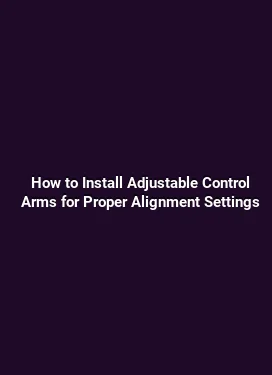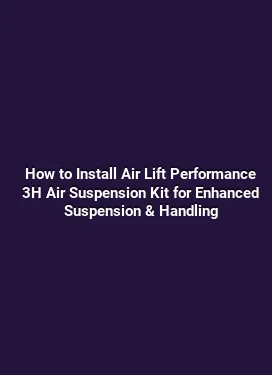How to Install Watts Link Conversion on Solid Axle Rear Suspension
Installing a Watts Link conversion on a solid axle rear suspension is a practical upgrade for enthusiasts seeking improved axle alignment, lateral stability, and predictable handling. Unlike traditional leaf springs that rely on simple geometry, a Watts Link uses a two-bar linkage to constrain the axle’s movement to a near-perfect vertical plane while allowing necessary articulation. This article delivers a thorough, hands-on approach, detailing planning considerations, component selection, workspace setup, and a careful, step-by-step installation process with practical tips, potential pitfalls, and real-world expectations.
Foundations of Watts Linkage in solid axle systems

At its core, a Watts Link is a four-bar linkage that connects the axle housing to the chassis through two parallel bars and a mid-link point that travels on a defined arc. The goal is to reduce lateral axle movement under cornering, braking, and accelerating loads, thereby maintaining tire contact and consistent drive behavior. In a solid axle layout, this translates to more stable wheel alignment, reduced tire scrub, and a more predictable steering response when the vehicle is unloaded and loaded unevenly. The conversion is particularly valuable on older or heavy-duty trucks and classic four-wheel-drive platforms where lateral movement of the axle can compromise steering feel and traction.
When selecting a conversion kit, it is important to consider the mounting geometry, bushing material, tongue length, and the ability to harmonize with existing axle detents. A well-matched Watts Link preserves suspension travel, avoids binding, and minimizes harshness by using appropriately rated pivots and bearings. Practically, you are aiming for a linkage that allows the axle to move vertically with minimal side-to-side drift, especially under lateral load during cornering or on uneven pavement surfaces.
Planning the upgrade: compatibility, goals, and space
Before lifting the vehicle, map out the compatibility of the Watts Link kit with your specific solid axle setup. Note the axle width, mounting points, and existing shock absorbers, as many installation scenarios require adapters or modified brackets. Define your handling goals: is the priority precise rear axle alignment, improved high-speed stability, reduced wheel hop, or better feedback in off-road conditions? Clarifying these objectives guides component choices and tuning strategy, including bushing hardness, bar lengths, and mounting positions.
Space and access matter as well. A typical installation demands a clear workspace with a solid workbench, jack stands, and a stable hoist. The installation will require disconnecting emergency brakes, removing some leaf spring hardware, and possibly relocating components such as brake lines or wiring harnesses. A clean, organized layout reduces the risk of misplacement and eases reassembly. Take careful photos before disassembly to reference torque patterns, bracket orientations, and hardware arrangement.
Key components to expect in a Watts Link conversion kit

Most kits include a pair of lateral link arms, a central mid-link, two mounting brackets, end housings, two pivot shafts, compliant bushings, fasteners, and a bracket for the mid-link bind. Some kits provide adjustable links to fine-tune the geometry after installation, which can be valuable when chasing precise rear-wheel alignment. High-quality kits use corrosion-resistant materials, sealed bearings or bushings that permit smooth articulation, and hardware that tolerates the engine’s vibration and road conditions. Inspect all components for flaws, ensure the finishes are intact, and verify that there are no burrs or sharp edges that could abrade components during articulation.
Tools, workspace, and safety considerations
A successful installation relies on a complete set of hand tools and a few specialty items. Common needs include metric and standard wrenches, socket sets, torque wrenches, pliers, a mallet, a pry bar, and a bench vise for bushings. A pneumatic or electric impact driver can speed up stubborn fasteners, but it should be used with care to avoid overtightening or stripping threads. A sturdy jack, jack stands, and wheel chocks are essential for safe lifting and supporting the axle while components are removed and reassembled. Safety first means wearing eye protection, gloves, and ensuring the vehicle is in a level, stable position throughout the procedure.
Step-by-step installation guide: from preparation to test drive
Preparation starts with a thorough cleanup of the rear suspension area. Remove the wheels to gain full access to the mounting points and inspect the leaf springs, shackles, and shocks for wear or fatigue. If any component is compromised, address it before starting the Watts Link installation. A clean, unobstructed workspace minimizes the risk of lost fasteners and misplacement of parts during reassembly.
Step one involves detaching the existing suspension components that interfere with the Watts Link installation. This typically includes disconnecting stabilizers, loosening or removing bolts that anchor the axle housing to the leaf springs, and freeing up room around the mounting brackets. Keep all hardware organized, labeling items that differ in size or type. Step two focuses on mounting the new side brackets or axle mounts at the specified positions according to the kit’s instructions. Correct alignment is crucial; use a straight edge and a level to verify that the brackets sit square to the chassis and that the axle sits centered between the frame rails. Step three covers installing the end links and the mid-link. Ensure pivot points are clean, free of debris, and that bushings seat evenly without binding as the links articulate through their travel range. Lubrication may be recommended for certain bushings or joints; apply as directed to minimize friction and wear.
As you progress, frequently check that the axle remains centered relative to the frame and that the linkages do not interfere with the brake lines, ABS wiring, or exhaust components. If the kit includes adjustable elements, begin with a conservative setting and plan a test sequence to evaluate how changes affect posture, ride quality, and steering feedback. After mounting the Watts Link, reattach components in the reverse order of removal, torque fasteners to the manufacturer’s specification, and recheck all clearances. A critical step is the final alignment check, ensuring the rear axle aligns with the vehicle’s reference geometry and that there is no unintended toe or camber deviation that could compromise handling or tire wear.
Tuning, alignment, and break-in considerations
Post-installation, a careful tuning phase helps translate the new geometry into tangible handling benefits. Start by performing a basic alignment check with the vehicle on a flat surface. If the kit allows, adjust the mid-link length or end-link positions to achieve the desired pinion angle and axle centering. The goal is a stable rear end that resists lateral movement under load while preserving sufficient articulation for rough pavement or off-road conditions. Record your baseline measurements and compare them after a few miles of driving to gauge the effect of the conversion on stability and tire contact.
During break-in, monitor for any unusual noises, binding, or changes in ride harshness. Slight squeaks or metallic sounds can indicate bushings that need time to settle or minor alignment tweaks. If vibrations or harshness appear at specific speeds or road conditions, recheck mounting hardware, ensure bushings are seated, and confirm that all fasteners remain torqued to spec. A well-tuned Watts Link should provide a noticeably steadier feel in straight-line driving and improved confidence during mid-corner transitions, especially on uneven road surfaces where axle movement previously exhibited lateral wandering.
Maintenance and longevity considerations
Even the best Watts Link installations benefit from periodic inspection. Check pivot pins for wear and lubricate or replace bushings according to usage and climate conditions. Inspect brackets and welds for signs of stress or cracking, particularly if the vehicle participates in off-road adventures or heavy towing. A simple maintenance routine, including visual inspections after long trips and periodic re-torqueing of critical fasteners, helps maintain performance and safety. When selling or trading the vehicle, documenting the installation and maintenance history can also support the perceived value and reliability of the upgrade.
Real-world expectations and performance scenarios
The conversion’s impact varies with vehicle weight, suspension stiffness, and driving style. In high-load cornering, a Watts Link helps keep the tire’s contact patch consistent, reducing the tendency for the axle to yaw or skate sideways. On rough pavement, better axle positioning contributes to a planted feel through the rear of the car, translating to more precise steering input and more predictable feedback for the driver. For off-road scenarios, the improved control of the aft axle can translate into smoother articulation over rocks, roots, and ruts, as the linkage limits hidden side loads that would otherwise disrupt traction. While the conversion adds complexity, many users report a notable improvement in confidence, steering response, and tire wear consistency once the system is properly tuned and aligned.
Common pitfalls and how to avoid them
One frequent issue is misalignment during installation. Take time to verify bracket orientation, precise mounting locations, and symmetrical side-to-side fit before tightening fasteners. A rushed job often leads to asymmetry, which can defeat the purpose of the conversion. Another pitfall is sourcing a kit that does not match the vehicle’s axle width or bolt pattern. An ill-fitting kit strains components, increases wear, and can create binding. Always confirm compatibility with your vehicle’s make, model, year, and axle configuration. Finally, avoid excessive force when inserting bushings or pins; use the recommended lube and follow the manufacturer’s torque specs to prevent premature wear or damage.
Frequently encountered questions and practical answers
People often ask about the durability of Watts Link systems, the impact on ride height, and how to balance rear geometry with front suspension dynamics. Real-world considerations include the compatibility with existing shocks, the effect on rear axle articulation, and the intended driving environment. In most cases, a well-executed Watts Link conversion maintains ride integrity while offering enhanced control under dynamic loads. The outcome is a more confident driving experience, especially for drivers who frequently encounter varying road surfaces or demanding loads. Below are practical considerations that address common concerns and provide actionable guidance for enthusiasts planning this upgrade.
Conclusion: embracing improved rear stability through thoughtful integration
This installation path offers a clear pathway to more stable rear-end behavior without compromising articulation or ride quality. By focusing on compatibility, proper mounting geometry, precise alignment, and disciplined maintenance, the Watts Link conversion on a solid axle rear suspension can deliver meaningful improvements in handling consistency and tire contact under demanding conditions. The process emphasizes careful planning, methodical assembly, and a measured approach to tuning—delivering tangible benefits to drivers who value precise, predictable feedback from their vehicle’s rear suspension.






